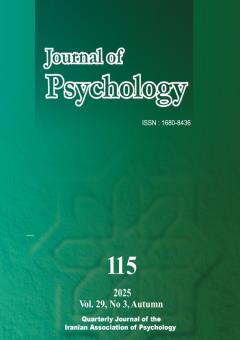About the journal
Journal of Psychology
Iranian Association of Psychology
International Union of Psychological Science (IUPsyS)
Recent Articles
-
Open Access Article
1 - Psychometric Properties of the Emotional Literacy Skills Questionnaire
razieh eatesamipour * ، Fereshteh Pourmohseni- KoluriIssue 3 , Vol. 29 , Autumn 2025 -
Open Access Article
2 - Investigating Psychometric Properties of the brain-compatible learning perception questionnaire
Fariborz Dortaj ، Atefeh Mazoosaz * ، Horieh Bagheri ، fazlollah hasanvandIssue 3 , Vol. 29 , Autumn 2025 -
Open Access Article
3 - The Relationship Between Proactive Personality and the Family's Emotional Climate With college Students’ Psychological Well-Being: The Mediating Role of Behavioral Self-Regulation
fatemeh dadvand * ، Mahboubeh Fouladchang *Issue 3 , Vol. 29 , Autumn 2025 -
Open Access Article
4 - The mediating role of creative self-beliefs in the effect of epistemological beliefs on students' intellectual risk-taking
Hemin KhezriAzar * ، Amineh RahnamaIssue 3 , Vol. 29 , Autumn 2025 -
Open Access Article
5 - The relationship between media literacy and psychological capital with students' academic engagement: testing the mediating role of social cognition
Abdoljalal Toomaj ، Siavash Talepasand * ، mohammad ali mohammadi farIssue 3 , Vol. 29 , Autumn 2025 -
Open Access Article
6 - Construction and validation of a scale for measuring the attitude towards having children in working women without children
Mohammad zaarei ، Samaneh Najjarpourian * ، abdolvahhab SamaviIssue 3 , Vol. 29 , Autumn 2025 -
Open Access Article
7 - Construction and Validation of the Psychological Emotional Harms Assessment Scale (PEAS) of Unwanted Marriage in Women: A Mixed Study
Iman Mesbah ، Esmaeil Sadri Damirchi * ، Ali Sheykholeslami ، ALI rezaei sharifIssue 3 , Vol. 29 , Autumn 2025 -
Open Access Article
8 - Analysis the factors affecting forgiveness of infidelity in traumatized women and men
Mohamad Ali Rahmani * ، raziyeh najiollahi malakshah ، Mohammadreza ZarbakhshIssue 3 , Vol. 29 , Autumn 2025 -
Open Access Article
9 - The mediating role of caring dimensions in the relationship between sexual satisfaction and attachment styles with women's sexuality
Zahra Madadi * ، Mohammad Zare Neyestanak *Issue 3 , Vol. 29 , Autumn 2025 -
Open Access Article
10 - Comparing the effectiveness of working memory training and Sternberg's successful intelligence on academic performance and social competence of high school students
Amene Zakeri * ، samane Tabatabaee * ، Toktam tabatabaee ، فاطمه شهابی زادهIssue 3 , Vol. 29 , Autumn 2025 -
Open Access Article
11 - The Effectiveness of Child-Centered Mindfulness Training on Emotion Management and Loneliness in Children with Mild Physical Disability
Ghasem Abullahi Baqrabadi * ، Khadija MohammadiIssue 3 , Vol. 29 , Autumn 2025 -
Open Access Article
12 - Comparison of Milon's psychopathology profile among Tattooed and Non-tattooed Adults in Mahabad city
galavizh alizadeh * ، shamal mahmoudi ، faezeh sohrabiIssue 3 , Vol. 29 , Autumn 2025 -
Open Access Article
13 - The Effectiveness of Paradox Therapy on Anxiety Symptoms in Diabetic Patients
Bahar Rafiezadeh ، Mohammad Ali Besharat * ، Hojjatollah FarahaniIssue 3 , Vol. 29 , Autumn 2025 -
Open Access Article
14 - The causal relationship between adolescent girls' self-destruction and mothers' irrational beliefs with the mediating role of parent-adolescent relationship
Ashraf Sadat Mousavi * ، mehri Khorrami NodehiIssue 3 , Vol. 29 , Autumn 2025 -
Open Access Article
15 - Predicting Social Health Based on Obsessive-Compulsive Symptoms: The Mediating Role of Self-Compassion
Bahman Esmaeili anamagh ، Niloofar Mikaeili *Issue 3 , Vol. 29 , Autumn 2025 -
Open Access Article
16 - Effectiveness of Group Existential Approach Training On Death Anxiety and Loneliness in Students With Symptoms Of Adult Separation Anxiety
farzaneh salehi * ، Kurosh Namdari ، Ahmad AbediIssue 3 , Vol. 29 , Autumn 2025 -
Open Access Article
17 - The effectiveness of paradoxical therapy on body image bias and coping strategies in obese individuals with body dysmorphic disorder
mahzad sadat mirian ، Shahnaz Khaleghipour * ، Alireza TaghvaeeIssue 3 , Vol. 29 , Autumn 2025 -
Open Access Article
18 - The relationship between behavioral brain systems and smartphone addiction in students: the mediating role of attachment style
Yeganeh Mohammadi Tahroodi ، Mojtaba Rajab pour *Issue 3 , Vol. 29 , Autumn 2025 -
Open Access Article
19 - Relationship between emotional maturity and marital self-disclosure with marital commitment: Investigating mediating role of attitude towards extramarital relationships in married women of Isfahan city
Aseyeh Sherafat ، nayere arianfar *Issue 3 , Vol. 29 , Autumn 2025 -
Open Access Article
20 - The Relationship Between Parental Perfectionism, Academic Burnout, and Resilience in Elementary School Students
Leila Sohrabizadeh * ، Majid Zargham HajebiIssue 3 , Vol. 29 , Autumn 2025
Most Viewed Articles
-
Open Access Article
1 - Language Development in Persian-Speaking 6- to 7-Year-Old Children
Mahnaz Dehghan Tezerjani * ، Parvin Kadivar ، Mohammad Hosein Abdollahi ، Hamid Reza HasanabadiIssue 2 , Vol. 22 , Summer 2018 -
Open Access Article
2 - The Relationship between Academic Optimism, and Teacher's Emotional Intelligence with the Student's Academic Achievement
Salman Ghanbarlou * ، Masoud Gholamali Lavasani ، Javad EjeiIssue 3 , Vol. 19 , Autumn 2015 -
Open Access Article
3 - Performance of Patients with Major Depressive Disorder in False Memory Task
Ali Heydari ، Alireza Moradi * ، Mohammad Hosein Abdollahi ، Hadi Parhun ، Yazdan NaderiIssue 2 , Vol. 19 , Summer 2015 -
Open Access Article
4 - Standardize the Vienna Matrix Test for Iran (WMTI) for Students between Ages 13-18 Years
Javad Ejei * ، Masoud Gholamali Lavasani ، Marzieyeh Rezaiee ، Zahra AkbariIssue 2 , Vol. 20 , Summer 2016 -
Open Access Article
5 - Comparison of the Brain/Behavioral Systems and Defense Mechanisms in Participants with Depression and Anxiety Traits
Marzie Pahlevan Mazandarani * ، Parviz Azadfallah ، Seyyed Mojtaba JazayeriIssue 3 , Vol. 18 , Autumn 2014 -
Open Access Article
6 - A Study of Psychometric Properties of Adolescent Self-Regulatory Inventory among Female Secondary Schools Students
Masoud Kiani * ، Elahe Hejazi ، Javad Ejei ، Masoud Gholamali LavasaniIssue 1 , Vol. 21 , Spring 2017 -
Open Access Article
7 - A Study of Psychometric Properties of Future Time Perspective Scale (FTPS) and its Relation to Academic Achievement
Mohsen Afshar * ، Elahe Hejazi ، Javad Ejei ، Nahid SadeghiIssue 2 , Vol. 22 , Summer 2018 -
Open Access Article
8 - Underling Mechanism of Relationship between Working Memory and Fluid Intelligence
Rouhollah Shahabi * ، Javad Ejei ، Parviz Azadfallah ، Vliyollah FarzadIssue 1 , Vol. 18 , Spring 2014 -
Open Access Article
9 - The Effect of a Group Counseling Based on Theory of Choice, and Reality Therapy on Inhancement of Social Adjustment and Self- Regulation in Adolescents
Seyed Rahman Hosseini * ، Javad Ejei ، Masoud Gholamali Lavasani ، Shiva KhaliliIssue 2 , Vol. 21 , Summer 2017 -
Open Access Article
10 - Investigating the Mediating Role of Achievement Goals in the Relationship between Need for Cognition and Cognitive Engagement: The Effect of Procrastination Context
Reza Ghorban Jahromi * ، Elahe Hejazi ، Javad Ejei ، Mohammad KhodayarifardIssue 1 , Vol. 19 , Spring 2015





